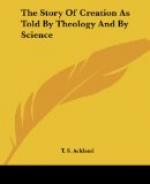Section 3. Simultaneous creation.
This objection may be very briefly disposed of, though it appears to be one which has made a very deep impression on Mr. Darwin. [Footnote: Origin of Species, p 1, &c.] It is entirely an inference drawn from the old interpretation of the six days. While that interpretation was received it followed, as a necessary consequence, that the creation of all kinds of plants on the third day, and of reptiles, birds, and mammalia on the fifth and sixth days respectively, must have been simultaneous. But if that interpretation is proved to be untenable, the inference drawn from it falls to the ground. The language of the narrative seems to point in an opposite direction. There is one instance in the chapter in which the words used seem to point to an instantaneous result. “And God said ‘Let light be’ and Light was,” though in this case the words probably have a further significance, which has been brought out by the discovery of the nature of light. But in these three cases the command is first recorded, with (in two cases) the addition “and it was so,” and then the narrative goes on to speak of the fulfilment of the command, as if the command and its fulfilment were distinct things.
Section 4. Death. Carnivorous animals.
These two objections may advantageously be considered together, since the fifth is in a great measure, though not entirely, dependent upon the fourth. For if death, in the common sense of the word, was unknown till the fall of Adam, it follows as a necessary consequence that no carnivorous creatures could have existed before that time. On the other hand, it may be considered as the natural death of large classes of animals to be devoured by the carnivora; so that if there were no carnivorous animals prior to the Fall, one of the avenues to death, at all events, had not been opened.
There is really no ground at all for the first of these objections in the actual history of Creation. It is only when the threat held out to Adam (ii. 17) is viewed in the light of St. Paul’s comment upon it (Rom. v. 12; viii. 20) that the supposition can be entertained. This, then, is the real foundation of the difficulty.
But, first of all, there is no reason to suppose that St. Paul’s words refer to any death but that of man. Now, it may well have been, that although man, having a body exactly analogous to those of the animals, would naturally have been subject, like them, to the ordinary laws of decay and death, yet in the case of a creature who possessed so much which raised him above the level of the lower animals, there may have been some provision made which should exempt him from this necessity. That this was the case appears probable from the mention made in the narrative of the Tree of Life. We have no intimation whether the action of the fruit of this tree was physical or sacramental, but that, in one way or other, it had the power to preserve man from physical death seems almost certain from the way in which it is spoken of after the Fall (iii. 22-24). But the mention of the Tree of Life leads to the inference that the case of Adam was entirely exceptional.




